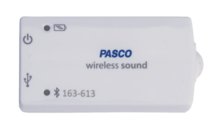
Wireless conductivity with display. Same quality with added access to current value.

Follow ionic levels in solution,


This water resistant sensor connects via Bluetooth® to measure both conductivity (ionic content in solution) and total dissolved solids in solution, and features a bright display of real-time readings for convenience in a variety of labs.
- 1x replaceable Li ion 300mAh rechargeable battery
See the Buying Guide for this item's required, recommended, and additional accessories.
Product Summary
The Wireless Conductivity Sensor with Display has an improved range and decreased error when measuring the electrical conductivity of aqueous solutions. Its bright organic light-emitting diode (OLED) display makes data points easy to read for quick spot checks even in bright sunlight. It is ideal for investigating the ionic properties of solutions, including calculations for total dissolved solids (TDS) often used for water quality inquiry. Temperature compensation handles calibrations across a range of temperatures. The new design supports a doubling of previous conductivity determination, now up to 40,000 µS/cm. This sensor can be utilized for chemical, biological, and environmental studies easily extending into brackish waters.
Teacher tip: To measure fully marine samples above sensor range, dilute your salt water solution in half then multiply sample conductivity x 2.
Features
- Measure conductivity and total dissolved solids
- Automatic temperature compensation
- Battery life >3 to 5 year rechargeable battery
- Remote logging with built-in memory
- Dust, sand, and water-resistant splashes or light rain, not immersion
- Able to monitor double replacement reactions to determine reaction completion
Applications
- Water quality investigations
- Performing condumetric titrations
- Investigating solution properties
- Diffusion of ions through membranes
- Differences between ionic and molecular compounds
- Comparing strong and weak acids
What's Included
- 1x replaceable Li ion 300mAh rechargeable battery
Product Specifications
| Auto shut off | 1 hour |
| Conductivity |
|
| Total Dissolved Solids |
|
| Response Time | 95% of final reading in 5 seconds or less |
| Probe Environmental Tolerance (Min-Max) | 0–80°C |
| Temperature Compensation | 0–35°C |
| Temperature Accuracy | ±0.5°C |
| Probe Material | The probe is composed of 300 series stainless steel and glass filled polypropylene |
| Water resistant | IPX4 handles splashes, light rain, not immersion |
| Connectivity | Bluetooth 5.2 |
| Logging | Yes |
| Battery Type | 300 mAh Li Ion |
| Battery Life | 3 years |
Battery & Logging
| Stored Data Points Memory (Logging) 1 | >35,000 |
| Battery - Connected (Data Collection Mode) 2 | >45 hr 1 week normal lab use |
| Battery - Logging (Data Logging Mode) 3 | >7 days |
| Battery Type | 300 mAh Li ion rechargeable |
1 Minimum # of data points with all measurements enabled, actual results depend on enabled measurements.
2 Continuous use in a connected state until battery failure, actual results will depend on sample rate, active measurements, and battery condition.
3 Logging until battery failure, actual results will depend on sample rate, active measurements, and battery condition.
* Normal classroom use is the sensor in active use for 20min/lab for 120 lab periods/yr.
Data Collection Software
This product requires PASCO software for data collection and analysis. We recommend the following option(s). For more information on which is right for your classroom, see our Software Comparison: SPARKvue vs. Capstone »
Buying Guide
| Recommended Accessories | P/N | |
|---|---|---|
| Electrode Support | PS-3505 | |
| Heater Stirrer | PS-3401 | |
| Wireless Drop Counter | PS-3214 |
Product Guides & Articles
Effective Strategies for Teaching Chemical Bonding
Imagine standing in front of your high school chemistry class, your students having entered with many possible things on their minds, some excited for the next lesson, others wondering who their next upcoming game will be against or what is the newest online trend. You’re ready to delve into exciting new territory, but you quickly discover that topics like Chemical Bonding could either spark curiosity or induce vapid yawns.
Experiment Library
Perform the following experiments and more with the Wireless Conductivity Sensor with Display.
Visit PASCO's Experiment Library to view more activities.
Types of Bonding
Students use a Conductivity Sensor to predict the type(s) of bonding between atoms in solutions made with different substances.
Cell Size
Students use a conductivity sensor to measure the effect of cell size on solute diffusion rate using agarose-salt cubes.
How Hard is Your Tap Water?
Students use conductometric titration and gravimetry to determine how much calcium carbonate is in a sample of tap water.
Ocean Currents
Students use a Temperature Sensor and a Conductivity Sensor to investigate the driving forces behind ocean currents.
Plasmolysis
Students use a conductivity sensor to explain the results of different concentrations of salt water on plant tissue before they design an experiment to compare the water potential of different plant tissues.
Drinking Water Quality: Hardness
How are total dissolved solids (TDS) measurements used to evaluate drinking water quality? In this investigation, students use a conductivity sensor to relate total dissolved solids (TDS) measurements with drinking water quality....
Stoichiometry: Mole Relationships in Reactions
Students use a Wireless Conductivity Sensor and Chemvue software to determine the ideal ratio between silver nitrate and an unknown reactant.
Electrolytes
Students use a Conductivity Sensor to distinguish an electrolyte from a non-electrolyte, and create a calibration curve to estimate the concentration of electrolytes in a sports drink.
Support Documents
| Manuals | ||
|---|---|---|
| Wireless Conductivity Sensor with OLED Display Manual | English - 374.39 KB | |
| Knowledge Base | ||
| Battery Replacement Matrix | Feb 7th, 2025 | |
| How do I troubleshoot connecting a wireless sensor? | Dec 13th, 2024 | |
| Windows asks for a PIN number when connecting wireless sensor or device | Feb 5th, 2025 | |
| Android asks for a PIN number to pair a wireless device to system | Aug 29th, 2023 | |
| Setting OLED sensors to SI units only | Jul 8th, 2024 | |
















